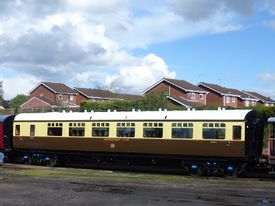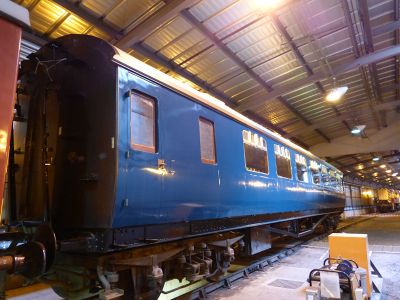GWR 9654 Restaurant Third
| GWR 9654 Restaurant Third | |
|---|---|
 GWR 9654 at Kidderminster (Apr 2017) | |
| Built By | GWR Swindon |
| Status | Operational |
| Number | 9654 |
| Other numbers | 10036, DW150326 |
| History | |
| Built | 1925 (rebuilt 1937) |
| Designed By | Collett |
| Diagram | H32 / H52 |
| Lot | 1359 |
| Type | RTO |
| Length | 58ft 0¼in |
| Weight | 31t 12cwt (as rebuilt) |
| Seats | 56 third |
| 1980 | Preserved (NRM) |
| 1981 | Loan to SVR |
| 2007 | Gifted to SVR |
| 2010 | Overhaul commenced |
| 2018 | Overhaul completed |
GWR 9654 is a Collett bow-ended Restaurant Third Open (RTO) carriage, originally built as part of one of the GWR's prototype articulated carriage sets.
GWR articulated carriages[edit | edit source]
Articulation involves two carriages sharing a single bogie. For a railway regularly using fixed formation sets, this yields potential benefits in terms of length, weight and space savings. However there are also downsides, including the difficulty of swapping out individual carriages within sets.
In 1925 the GWR built six prototype 8-car articulated sets. Each set comprised a first class articulated pair, a restaurant/kitchen car articulated triplet and a third class articulated triplet. The layout, with carriages numbered left to right, was as follows (articulated bogie with ratchet coupling shown as "#", conventional screw coupling shown as "="):
=[Corridor brake first]#[Corridor first]=[First diner]#[Kitchen car]#[Third diner]=[Corridor third]#[Corridor third]#[Corridor brake third]=
The first and third class diners were both 50ft 6¾in long and were separated by the 46ft 3in kitchen car whose positioning, as well as serving both dining cars, ensured that first and third class remained segregated.[1]
The GWR initially gave the sets a high commercial profile, including allocating them the significant new 100xx number series. The first set to be completed, numbered 10000-10007, represented the GWR at the Railway Centenary Exhibition in July 1925 (together with Castle 111 Viscount Churchill newly rebuilt from the "Great Bear") and then entered service on Plymouth ocean liner boat trains. The other seven sets completed later that year were used on flagship services from Paddington to Birkenhead, Paddington to South Wales, and Channel Island boat trains. However the arrival of the 60ft flush-sided stock in 1930 saw the articulated sets transferred onto more mundane Cheltenham and Weymouth express services, and by 1935 their usefulness had become limited. During 1936-37 all the carriages were rebuilt to approximately the 57ft length of the equivalent 1920s non-articulated stock by splicing in extra frame lengths and adding new body sections[1].
Service[edit | edit source]
10036 (as it was originally numbered) was one of the six third class articulated ("Tri-art") dining carriages built in 1925 as Lot 1359 to Diagram H32, its triplet also including dining first 10034 and restaurant car 10035.
In 1935, the GWR introduced their new "Excursion Stock". Two of the six dining car triplets, one of which was 10018-20,[note 1] were temporarily assigned to the second set "GWR VT No. 2" in April 1935, with the dining cars acting as temporary open thirds until sufficient new 1936 open thirds were available. In April 1936, third 10020 (renumbered 9653), third 10036 (renumbered 9654), first 10018 (9655) and first 10034 (9656) were all rebuilt as third class dining carriages to Diagram H52 which included seven bays totalling 56 seats, allowing space for a large vestibule with one toilet and a linen storage cupboard. All were mounted on 7ft bogies.[1][note 2]
After conversion, service continued into the BR era which resulted in the usual renumbering to W9654W. The ex-dining cars were seen on additional services such as Paddington to Birmingham extras or Newbury race trains as late as 1961.[1]
W9654W was withdrawn from passenger services and transferred into Departmental stock in January 1962 as No DW150326. In response to the increasing "cold war" tensions, the government of the day established a number of regional control trains to act as mobile communication control centres in the event of a nuclear attack. W9654W and sister coach 9653 both formed part of the second WR Control Train, along with five Diagram C57 Full Thirds which were stripped out and converted for office use. This particular train was stored in the Carriage Shed at Craven Arms, from where it would presumably have been moved to shelter in Sugar Loaf Tunnel in the face of an imminent threat[2].
Preservation[edit | edit source]
Since the control trains were officially secret, preservation groups were concerned that once withdrawn, they might be scrapped without notice. The Great Western (SVR) Association made periodic "unofficial visits" to Craven Arms to monitor their status. In the event, when the train was disbanded, the coaches were put up for tender. The Association bid for both 9653 and 9654, but were thwarted by the NRM who claimed both for the National Collection.[2] However several coaches restored by the SVR had taken part in the Rocket 150 event the previous year, and this probably helped the Association reach an agreement with the NRM for the pair to come to the SVR on loan, where they would similarly be restored to full running order. Both arrived on the SVR from York on 18 August 1981. After receiving attention, mainly to make them watertight and install communication cord gear, both were used in that year's Enthusiasts Weekend where they proved popular.[3]
9653 then underwent a full restoration in 1982, with 9654 receiving the same treatment in 1983.[4] After completion, both saw regular use on dining trains.[5] 9654 was withdrawn from this service for three weeks in 1988 while a leaking roof was repaired.[6] In 1990 9654 was repainted in Hawksworth livery, with a number of other improvements being carried out at the same time. Externally, low lever water filler pipes were added to save volunteers having to climb on the roof to fill the water tanks. Internally the toilet and linen cupboard, which had been removed by BR, were reinstated with the vestibules being finished with matchboard panelling in mahogany with birch inlay. Pictures and panelling were also added in the saloon.[7]
The coach was used in Carlton's made-for-TV movie 'Goodnight Mister Tom' in 1998 along with two other Great Western coaches.
Around 2003, 9654 moved into the yard at Bewdley where it began what became a 'stop start' interior repair.[8] The NRM had indicated that they wanted both 9654 and 9653 returned, with work on 9654 therefore being paused. However after the NRM realised that both were identical,[9] an agreement was reached in spring 2007 whereby 9654 was gifted to SVR(H) with 9653 planned to return in 2008/09.[2]
After some time was spent on repairs to 9653, 9654 entered Bewdley Paint Shop in early 2010 for major repair work to be completed. These included frame repairs, overhaul of the external doors and renewal of the floor. However by September 2010 the SVR was in a period of financial uncertainty. After discussion, the Bewdley C&W site was kept open by agreeing to switch to external fee-earning contract work, so 9654 was moved into storage in the yard. Sone further interior work was carried out in 2011 before 9654 moved to Kidderminster.[10] By 2015, 9654 was still stored awaiting completion of the overhaul, having received a coating of blue protective paint.
-
GWR 9654 in storage on 18 July 2015
By the beginning of August 2015, 9654 had returned to Bewdley. In 2017 it was still at Bewdley for work including repainting and the fitment of the correct pattern of luggage racks, with outstanding works including lavatories and seating. After final finishing at Kidderminster, 9654 re-entered service in July 2018, making its debut on a wedding charter.[11]
See also[edit | edit source]
Notes[edit | edit source]
- ↑ Harris (1966) does not confirm the identity of the second triplet, however it appears likely to have been 10034-36 from the dates of the subsequent rebuilds.
- ↑ The dining cars from other four articulated sets were rebuilt between June 1936 and July 1937, retaining their original class as First Diners (Diagram H50) and Third Diners (Diagram H51 seating 64 in 8 bays)
References[edit | edit source]
Links[edit | edit source]
| ||||||||||||||||||||||||||||||
